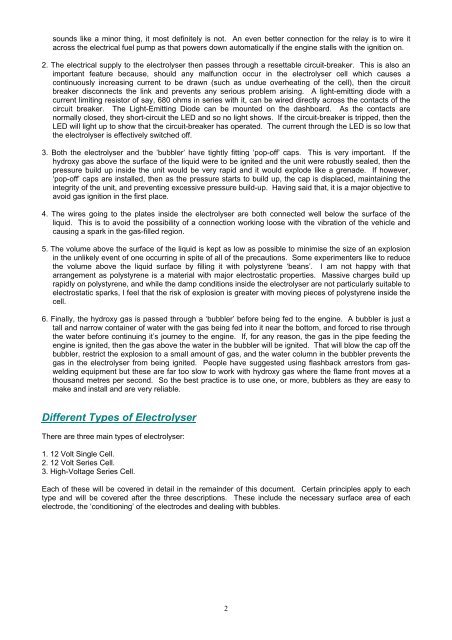Electrolyser designs - Free Energy Info
Electrolyser designs - Free Energy Info
Electrolyser designs - Free Energy Info
- No tags were found...
You also want an ePaper? Increase the reach of your titles
YUMPU automatically turns print PDFs into web optimized ePapers that Google loves.
sounds like a minor thing, it most definitely is not. An even better connection for the relay is to wire itacross the electrical fuel pump as that powers down automatically if the engine stalls with the ignition on.2. The electrical supply to the electrolyser then passes through a resettable circuit-breaker. This is also animportant feature because, should any malfunction occur in the electrolyser cell which causes acontinuously increasing current to be drawn (such as undue overheating of the cell), then the circuitbreaker disconnects the link and prevents any serious problem arising. A light-emitting diode with acurrent limiting resistor of say, 680 ohms in series with it, can be wired directly across the contacts of thecircuit breaker. The Light-Emitting Diode can be mounted on the dashboard. As the contacts arenormally closed, they short-circuit the LED and so no light shows. If the circuit-breaker is tripped, then theLED will light up to show that the circuit-breaker has operated. The current through the LED is so low thatthe electrolyser is effectively switched off.3. Both the electrolyser and the ’bubbler’ have tightly fitting ‘pop-off’ caps. This is very important. If thehydroxy gas above the surface of the liquid were to be ignited and the unit were robustly sealed, then thepressure build up inside the unit would be very rapid and it would explode like a grenade. If however,‘pop-off’ caps are installed, then as the pressure starts to build up, the cap is displaced, maintaining theintegrity of the unit, and preventing excessive pressure build-up. Having said that, it is a major objective toavoid gas ignition in the first place.4. The wires going to the plates inside the electrolyser are both connected well below the surface of theliquid. This is to avoid the possibility of a connection working loose with the vibration of the vehicle andcausing a spark in the gas-filled region.5. The volume above the surface of the liquid is kept as low as possible to minimise the size of an explosionin the unlikely event of one occurring in spite of all of the precautions. Some experimenters like to reducethe volume above the liquid surface by filling it with polystyrene ‘beans’. I am not happy with thatarrangement as polystyrene is a material with major electrostatic properties. Massive charges build uprapidly on polystyrene, and while the damp conditions inside the electrolyser are not particularly suitable toelectrostatic sparks, I feel that the risk of explosion is greater with moving pieces of polystyrene inside thecell.6. Finally, the hydroxy gas is passed through a ‘bubbler’ before being fed to the engine. A bubbler is just atall and narrow container of water with the gas being fed into it near the bottom, and forced to rise throughthe water before continuing it’s journey to the engine. If, for any reason, the gas in the pipe feeding theengine is ignited, then the gas above the water in the bubbler will be ignited. That will blow the cap off thebubbler, restrict the explosion to a small amount of gas, and the water column in the bubbler prevents thegas in the electrolyser from being ignited. People have suggested using flashback arrestors from gasweldingequipment but these are far too slow to work with hydroxy gas where the flame front moves at athousand metres per second. So the best practice is to use one, or more, bubblers as they are easy tomake and install and are very reliable.Different Types of <strong>Electrolyser</strong>There are three main types of electrolyser:1. 12 Volt Single Cell.2. 12 Volt Series Cell.3. High-Voltage Series Cell.Each of these will be covered in detail in the remainder of this document. Certain principles apply to eachtype and will be covered after the three descriptions. These include the necessary surface area of eachelectrode, the ‘conditioning’ of the electrodes and dealing with bubbles.2
















